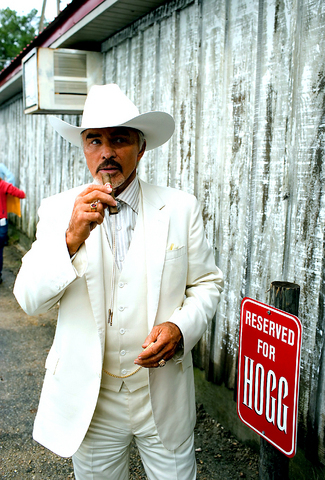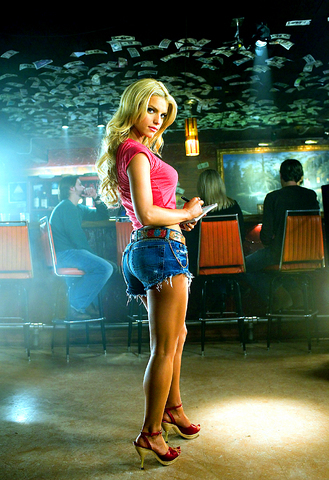The Dukes of Hazzard is the latest evidence that, for Hollywood studios at least, there can never be too much of a mediocre thing.
Some folks who were in grade school in the late 1970s and early 1980s may have fond memories of the original CBS series, which caught the tail end of the era's rednexploitation boom, but those people are probably perfectly happy to watch reruns on cable. The series' enduring contribution to the culture was lending the name of one of its secondary characters to cutoff denim shorts. Come to think of it, that may be the reason for this thoroughly pointless big-screen adaptation, which features the enigmatic Jessica Simpson as Daisy Duke, the sight of whose body will apparently turn any man in the state of Georgia into a drooling moron.
Which, according to this picture, is a pretty short trip. The Dukes of Hazzard, directed by Jay Chandrasekhar (Super Troopers) from a script by John O'Brien (Starsky and Hutch), sells itself as a good-natured exercise in rebel pride, a red-blooded red-state romp replete with moonshine, shotguns, stock car rallies and Southern belles. (There is also, by the way, quite a lot of swearing for a PG-13 movie.) But let's be honest: what this really is is a white-face minstrel show, which happily traffics in stereotypes, hoping that the people being made fun of -- white, rural Southerners -- will laugh along instead of picketing or writing angry letters. (If the box-office performances of the season's other two big television-recycling movie projects -- The Honeymooners and Bewitched -- are any indication, what Southerners and most other Americans are more likely to do is stay home.)

It would help if the movie were actually funny -- or if it actually bothered to be a movie, rather than some car chases punctuated by shots of Simpson sashaying toward the camera (or more often, away from it). There is very little real Southern flavor or humor, though a few supporting performances are amusing (notably Kevin Heffernan as the Dukes' pal Sheev), and some of the automotive mayhem is fun, especially when it partakes of the anarchic spirit of Johnny Knoxville's do-it-yourself Jackass stunts.
Knoxville plays Luke, who rides shotgun in the General Lee, the bright orange Dodge Charger driven by his cousin Bo (Seann William Scott). Scott (no relation) deploys the same antic, wide-mouthed goofiness he brought to the American Pie movies, but with facial stubble as unconvincing as the Southern accent he occasionally tries out. Knoxville, whose adopted surname is a tribute to his Tennessee hometown, is a bit more credible as a good ol' boy.
Not that authenticity is really the point, notwithstanding the participation of Willie Nelson and of Burt Reynolds, who personified mid-1970's Southern macho in movies like Gator and of course Smokey and the Bandit. Reynolds, in a white Cadillac and a matching ice cream suit, is Boss Hogg, the corrupt local official who is Luke and Bo's nemesis. He is seizing land -- including the Duke farm -- to convert Hazzard County into a strip mine, and using a hometown racing legend named Billy Prickett (James Roday) to advance his dastardly scheme.

PHOTO: REUTERS
The Duke boys run moonshine for their Uncle Jesse, played by Nelson with the mellow ease of a man who can earn a paycheck just by showing up. Well, he does a little more than that. He tells a few bad jokes, punches Reynolds in the face and then sings the old Dukes of Hazzard theme song over the final credits and the blooper reel.

PHOTO: AP

In the March 9 edition of the Taipei Times a piece by Ninon Godefroy ran with the headine “The quiet, gentle rhythm of Taiwan.” It started with the line “Taiwan is a small, humble place. There is no Eiffel Tower, no pyramids — no singular attraction that draws the world’s attention.” I laughed out loud at that. This was out of no disrespect for the author or the piece, which made some interesting analogies and good points about how both Din Tai Fung’s and Taiwan Semiconductor Manufacturing Co’s (TSMC, 台積電) meticulous attention to detail and quality are not quite up to

April 21 to April 27 Hsieh Er’s (謝娥) political fortunes were rising fast after she got out of jail and joined the Chinese Nationalist Party (KMT) in December 1945. Not only did she hold key positions in various committees, she was elected the only woman on the Taipei City Council and headed to Nanjing in 1946 as the sole Taiwanese female representative to the National Constituent Assembly. With the support of first lady Soong May-ling (宋美齡), she started the Taipei Women’s Association and Taiwan Provincial Women’s Association, where she

Chinese Nationalist Party (KMT) Chairman Eric Chu (朱立倫) hatched a bold plan to charge forward and seize the initiative when he held a protest in front of the Taipei City Prosecutors’ Office. Though risky, because illegal, its success would help tackle at least six problems facing both himself and the KMT. What he did not see coming was Taipei Mayor Chiang Wan-an (將萬安) tripping him up out of the gate. In spite of Chu being the most consequential and successful KMT chairman since the early 2010s — arguably saving the party from financial ruin and restoring its electoral viability —

It is one of the more remarkable facts of Taiwan history that it was never occupied or claimed by any of the numerous kingdoms of southern China — Han or otherwise — that lay just across the water from it. None of their brilliant ministers ever discovered that Taiwan was a “core interest” of the state whose annexation was “inevitable.” As Paul Kua notes in an excellent monograph laying out how the Portuguese gave Taiwan the name “Formosa,” the first Europeans to express an interest in occupying Taiwan were the Spanish. Tonio Andrade in his seminal work, How Taiwan Became Chinese,